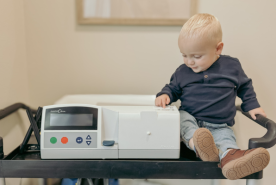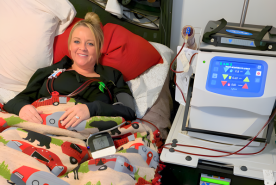Proper care of your PD catheter is key to preventing infections and ensuring effective treatment. Follow cleaning and monitoring guidelines to maintain catheter function.
Taking good care of the PD catheter and the skin around it (called the exit site) is the most important way to keep the catheter working well and to lower the chance for infection.
Right After Your Catheter is Placed
After the catheter is placed, a sterile gauze bandage is usually taped over the exit site to stop the catheter from moving and to keep the area clean. For the first 7 to 10 days, the exit site is usually left alone. After that, the bandage is first changed by a PD nurse under sterile conditions. The catheter should not be moved or touched a lot, because this can increase the chance for infection.
After the first two weeks, the skin around the catheter should not be red or painful. The skin should feel soft. There may be a small amount of thick, yellow mucus. A crust or scab may form every few days.
If the skin is red, painful, feels hard, or there is pus around the catheter, there may be an infection. Contact your center right away.
The skin around the catheter should be kept dry until it is well healed -- about 10 to 14 days. You should not take a shower or bath or go swimming during this time. These water sources are not sterile and can cause an exit site infection. A washcloth or sponge may be used to clean the body, although you should be careful to keep the catheter and bandage dry. You will be able to shower when cleared by your PD nurse.
While healing, you should not exercise too hard or do much lifting. The exit site should be completely healed at 4-6 weeks.
It is important to prevent constipation after the catheter is placed. Straining to move your bowels can increase the chance for a hernia (a weakness in the belly muscle). Not moving your bowels enough can lead to problems with catheter function (slow drain time or problems with completely draining the belly).
To prevent or treat constipation, your health care team may recommend a high fiber diet along with the right amount of fluid to help you pass stool more easily. They may also order a stool softener or laxative.
Long-Term Care
Your PD nurse will teach you about how to keep your exit site and catheter clean. Keeping this area clean will lower the chance of skin infection, as well as infection inside the belly, called peritonitis (pe-ri-tah-ny-tis). If you get peritonitis, it must be treated right away. If you get peritonitis many times, or if it lasts a long time, then you may need to stop PD and change to hemodialysis.
Most centers will recommend that you keep the catheter in place with tape. If the catheter moves a lot, you can harm the exit site. Do not let clothes tug on your catheter.
The skin around the exit site should be washed every day or every other day with antibacterial soap or cleanser recommended by your center that does not irritate the skin. The soap should stay in the same bottle it came in (not poured into another bottle). Bar soap is not recommended because germs can grow on it. Other types of cleansers, such as hydrogen peroxide or alcohol, should NOT be used unless your healthcare team tells you to do so.
These are general guidelines – you center may have some more specific or different instructions:
- Before cleaning the area, always wash your hands with soap and water and put on clean gloves.
- Hold the catheter in place during cleaning to prevent injury to the skin.
- Do not pick or remove crusts or scabs at the exit site.
- Clean with antibacterial soap or cleanser. Rinse with sterile water or saline.
- After cleaning, gently pat the skin dry around the exit site with a clean cloth or towel. Use the cloth or towel only one time and do not use it on other parts of the body.
- Put antibiotic cream on the skin around the catheter with a cotton-tip swab every time the dressing is changed. Your center will order the type of cream they want you to use. This will help prevent infections. Do not use any creams with petroleum because they can damage the catheter.
- The exit site should be covered with sterile gauze, which should be changed every time the site is cleaned. The catheter should be stuck to the skin with special tape that allows the skin to get air. Your PD nurse will tell you which tape to use.
With good exit site care, most PD catheters have no problems and work for many years. If the catheter does not work or is no longer needed, it is removed with minor surgery.
References
- Zorzanello MM. Approaches to care by the APRN in peritoneal dialysis. In: Counts CS, Alleman K, Houle K (eds). Core Curriculum for Nephrology Nursing. 6th Edition. Pitman, New Jersey: American Nephrology Nurses' Association;2015: Module 6, Chapter 3, Section D.
- Burkart JM. Patient education: peritoneal dialysis (beyond the basics). Golper TA, Lam AQ (eds). UpToDate. Accessed 18 December 2018. https://www.uptodate.com/contents/peritoneal-dialysis-beyond-the-basics?topicRef=1885&source=see_link








